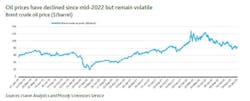Moody’s: Opposing market forces to keep oil prices highly volatile
Average oil prices should remain below 2022’s $100/bbl average for international Brent benchmark, but exceed the medium-term price of $50-70/bbl, according to a Jan. 17 report from Moody’s Investors Service.
“Oil price trajectory this year remains uncertain and depends on economic outcomes in major economies,” said Madhavi Bokil, senior vice-president, CSR, Moody’s, and an author of the analysis. “We expect two opposing market forces will keep oil prices highly volatile this year: a slowdown in demand and restricted supply.”
Recent price drop
Brent crude oil prices declined to about $80/bbl as of Jan. 3 from over $120/bbl in June 2022, a 33% decline in just 6 months, despite global supply constraints and lingering uncertainty about Russian producers' ability to maintain export volumes amid sanctions.
“The decline in oil prices since June reflects reduced market expectations for growth in oil demand amid heightened recession risks in the US and Europe and a short-term decline in oil demand from China amid COVID restrictions,” the report said.
“These factors outweighed market concerns about supply constraints and declining global inventory levels. As estimates for 2023 oil demand moderated, so did the risks of spiking prices from the December implementation of the US and European oil price cap, and Russia's threat to divert oil and refined product sales away from countries supporting the price cap.”
Oil demand uncertainty
The uncertainty about growth in oil demand in Europe, the US, and emerging markets is unusually high and risks to oil prices are in both directions. The report said that, should economic weakness in China, Europe, or the US persist or worsen, oil prices may weaken well below current levels of $80/bbl.
Alternatively, economic resilience in the US and Europe, coupled with stronger-than-expected post-COVID growth in China, would support higher prices. Furthermore, with China dropping its zero-COVID policy, a post-COVID rebound in mobility and economic activity may bring a rapid if uneven recovery in demand, causing price volatility.
Constrained supply
The other driver supporting prices is constrained supply. In November 2022, the OPEC group of oil producing countries initiated proactive production cuts in anticipation of weaker demand this year. The oil industry, including shale producers in the US, is managing rising production and regulatory costs that constrain investment and production growth this year.
Therefore, Moody’s expects that a decline in prices to below $70/bbl will prompt a swift reduction in supply, causing a rebalancing at higher price levels. Falling prices should also accelerate efforts to rebuild depleted inventory globally, including the US Strategic Petroleum Reserve (SPR), which would support price recovery.
“Constrained oil supply should continue to support oil prices. Global spare capacity is limited and concentrated in Saudi Arabia and Russia and is low elsewhere. Should demand for oil rebound, say when China's transportation demand picks up, oil prices may rise abruptly to mid-2022 levels because supply will not be able to adjust quickly to the recovery in Chinese demand,” the report said.

